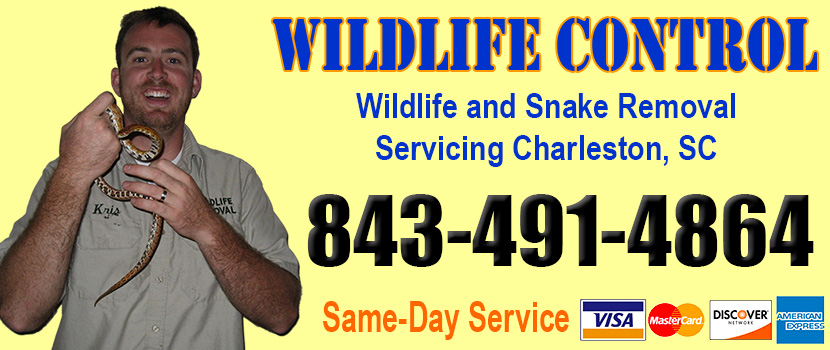
Welcome to charlestonsnakes.com! I am David, a snake enthusiast living in Charleston, SC. Many people don't know that Charleston is in fact full of snakes! You just need to know where to find them - they can often be shy and elusive. Some South Carolina snake species are more common outside of the city limits, in different parts of Charleston County SC, but many types of snakes are indeed common in the more urban parts of Charleston. This guide is meant to help educate you about the beautiful snakes of Charleston, and to help you identify the most common snakes of Charleston, as well as the venomous snakes of Charleston that you should learn to recognize and avoid. If you want more detail, click here for my complete list of ALL snake species in Charleston. Remember the following:
- Most snakes of Charleston are harmless and don't want to encounter you
- Venomous snakes exist but are uncommon in Charleston, South Carolina
- Snakes eat rats and mice and are a valuable part of the South Carolina ecosystem
- Never kill a snake - if you leave a snake alone, it will leave you alone.
Common Snake Species in Charleston
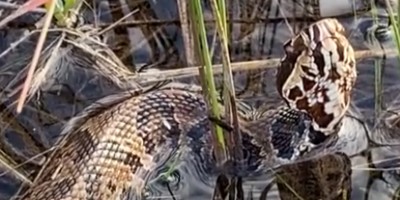 Water moccasin:
A characteristic feature of these snakes which are found in Charleston, South Carolina, is their white mouth lining which can be easily seen when they open their mouths. These snakes can grow as long as five feet. However, their average length is between three feet and four feet. The snakes have irregular patterns spread across their bodies. The color of the bodies of water moccasins can be black, dark olive, and tan, amongst others. A notable behavioral pattern of these snakes is that they do not retreat when faced with a threat. They stay put and coil tightly. These venomous snakes are commonly found in aquatic environments.
Water moccasin:
A characteristic feature of these snakes which are found in Charleston, South Carolina, is their white mouth lining which can be easily seen when they open their mouths. These snakes can grow as long as five feet. However, their average length is between three feet and four feet. The snakes have irregular patterns spread across their bodies. The color of the bodies of water moccasins can be black, dark olive, and tan, amongst others. A notable behavioral pattern of these snakes is that they do not retreat when faced with a threat. They stay put and coil tightly. These venomous snakes are commonly found in aquatic environments.
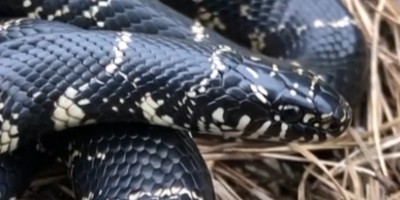 Eastern kingsnake:
The eastern kingsnake is found in Charleston as well as other parts of South Carolina and are one of the most commonly encountered snakes. They get their name because of the chain-link bands that cross their backs and sides. The bands are white or yellow in color. These snakes are large with an average length of 36 inches to 48 inches. The snakes are encountered during the day as they are most active in the daytime. They feed on a wide variety of small animals and reptiles. The snakes are known for their resistance to the venom of pit vipers. They can eat pit vipers such as copperheads and rattlesnakes. They are found in a wide variety of habitats, including terrestrial and aquatic habits.
Eastern kingsnake:
The eastern kingsnake is found in Charleston as well as other parts of South Carolina and are one of the most commonly encountered snakes. They get their name because of the chain-link bands that cross their backs and sides. The bands are white or yellow in color. These snakes are large with an average length of 36 inches to 48 inches. The snakes are encountered during the day as they are most active in the daytime. They feed on a wide variety of small animals and reptiles. The snakes are known for their resistance to the venom of pit vipers. They can eat pit vipers such as copperheads and rattlesnakes. They are found in a wide variety of habitats, including terrestrial and aquatic habits.
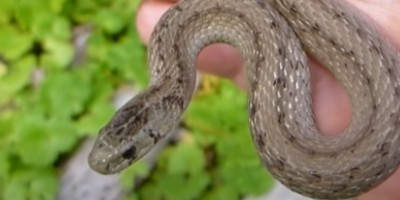 Brown snake:
As per their name, the brown snake has a brown body. They are small snakes, with an average length of 6 to 13 inches. Their bodies can also be reddish, grayish, or grayish-brown. They are commonly encountered in Charleston, South Carolina, in urban areas. In these areas, they make their habitats in dry areas as well as wetland areas. They typically hide under logs and litter. The diet of the snakes is made up of animals such as soft-bodied invertebrates.
Brown snake:
As per their name, the brown snake has a brown body. They are small snakes, with an average length of 6 to 13 inches. Their bodies can also be reddish, grayish, or grayish-brown. They are commonly encountered in Charleston, South Carolina, in urban areas. In these areas, they make their habitats in dry areas as well as wetland areas. They typically hide under logs and litter. The diet of the snakes is made up of animals such as soft-bodied invertebrates.
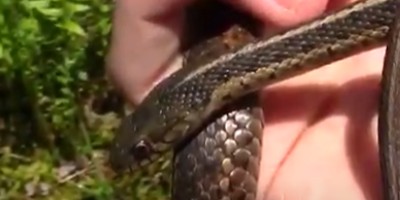 Eastern garter snake:
The eastern garter snake can be distinguished based on the three longitudinal stripes on its body. These snakes have an average length of 18 inches to 26 inches. The eastern garter snake is commonly encountered in Charleston, South Carolina, where it is found close to bodies of water or in marshy environments.
Eastern garter snake:
The eastern garter snake can be distinguished based on the three longitudinal stripes on its body. These snakes have an average length of 18 inches to 26 inches. The eastern garter snake is commonly encountered in Charleston, South Carolina, where it is found close to bodies of water or in marshy environments.
Venomous Snake Species in Charleston
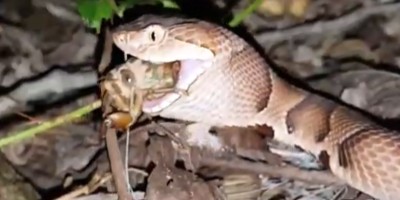 Copperhead:
Copperheads are found in Charleston as well as the rest of the state. The snakes maintain a wide range of habitats and are one of the most commonly encountered venomous snakes in the state. The camouflaging abilities of this snake help them to avoid being detected. The snakes also have nocturnal habits. These venomous snakes strike when they feel threatened. They release venoms in their bites, although their bites have been described to not be as dangerous as that of other venomous snakes like water moccasins. The pit vipers have a copper-colored head, from which they get their name. They can grow as long as four feet. However, their average length is between two to three feet.
Copperhead:
Copperheads are found in Charleston as well as the rest of the state. The snakes maintain a wide range of habitats and are one of the most commonly encountered venomous snakes in the state. The camouflaging abilities of this snake help them to avoid being detected. The snakes also have nocturnal habits. These venomous snakes strike when they feel threatened. They release venoms in their bites, although their bites have been described to not be as dangerous as that of other venomous snakes like water moccasins. The pit vipers have a copper-colored head, from which they get their name. They can grow as long as four feet. However, their average length is between two to three feet.
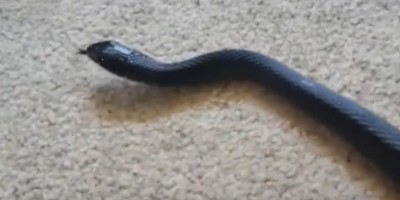 Black racers:
They are commonly found in Charleston and known for their daytime activity. The non-venomous snakes are medium-sized and mostly black in color. They can be as long as 52 inches and are typically slender. Black racers are known for their agile nature. They can quickly flee and climb onto trees when they are faced with a threat. Occasionally, black racers stand their ground and attempt to strike the intruder. Black racers are found in a wide range of habitats, particularly edge habitats like forest edges and wetland edges. The snakes are most active during the day, and they are more encountered during the day. Black racers feed on lizards and other small reptiles. They could be easily mistaken for other snakes.
Black racers:
They are commonly found in Charleston and known for their daytime activity. The non-venomous snakes are medium-sized and mostly black in color. They can be as long as 52 inches and are typically slender. Black racers are known for their agile nature. They can quickly flee and climb onto trees when they are faced with a threat. Occasionally, black racers stand their ground and attempt to strike the intruder. Black racers are found in a wide range of habitats, particularly edge habitats like forest edges and wetland edges. The snakes are most active during the day, and they are more encountered during the day. Black racers feed on lizards and other small reptiles. They could be easily mistaken for other snakes.
If you're unsure, you can email me a photo of the snake at info@charlestonsnakes.com and I will email you back with the snake's species. If you found a snake skin, read my Found a Skin? page, and you can email me a photo of the skin, and I'll identify the snake for you. If you need professional Charleston snake removal help, click my Get Help page, or see the below website sponsor I found, who provides that service.
Remember, the term is not poisonous snakes of Charleston, it's venomous snakes of Charleston. Poison is generally something you eat, and venom is injected into you. That said, dangerous snakes are very rare in Charleston. The few venomous snakes of Charleston County are rarely seen. But they are commonly misidentified, so learn about all the snake species of Charleston in order to correctly identify them. These snakes are usually also found in the surrounding towns of Mount Pleasant, Folly Beach, Isle of Palms, Kiawah Island, Sullivan's Island, Edisto Island, Seabrook Island, Ravenel, Awendaw, McClellanville, Hollywood, Meggett, Lincolnville, Rockville, and the surrounding areas.
Read our article about:
4 Things to Do After Catching a Snake
charlestonsnakes.com domain and hosting costs made possible by the generous support of this sponsor:
